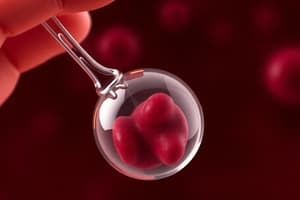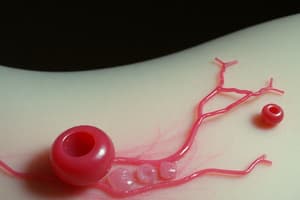Podcast
Questions and Answers
What is the initial response to injury in the process of hemostasis?
What is the initial response to injury in the process of hemostasis?
- Platelet Plug Formation
- Vascular Spasm (correct)
- Platelet Adhesion
- Blood Coagulation
What is released by damaged endothelial cells to aid in platelet adhesion during plug formation?
What is released by damaged endothelial cells to aid in platelet adhesion during plug formation?
- Thromboxane A2
- Fibrinogen
- Von Willebrand factor (vWF) (correct)
- ADP
What do adhered platelets release during the release reaction in plug formation?
What do adhered platelets release during the release reaction in plug formation?
- ADP (correct)
- Fibrinogen
- Von Willebrand factor (vWF)
- Thromboxane A2
What activates the intrinsic pathway of blood coagulation?
What activates the intrinsic pathway of blood coagulation?
What do injured tissues release to initiate the extrinsic pathway of blood coagulation?
What do injured tissues release to initiate the extrinsic pathway of blood coagulation?
Which factor combines with other factors to form thrombin during blood coagulation?
Which factor combines with other factors to form thrombin during blood coagulation?
What leads to the formation of a temporary 'platelet plug' that covers the breach in the vessel wall?
What leads to the formation of a temporary 'platelet plug' that covers the breach in the vessel wall?
What is the role of thrombin in blood coagulation?
What is the role of thrombin in blood coagulation?
What is the function of clot retraction?
What is the function of clot retraction?
What is the purpose of negative feedback mechanisms in hemostasis?
What is the purpose of negative feedback mechanisms in hemostasis?
What is the function of anticoagulant Heparin?
What is the function of anticoagulant Heparin?
What is the effect of positive feedback during platelet activation?
What is the effect of positive feedback during platelet activation?
What is the primary role of fibrin threads in blood coagulation?
What is the primary role of fibrin threads in blood coagulation?
What is the function of protein C and S in hemostasis?
What is the function of protein C and S in hemostasis?
What is the primary role of anticoagulant Antithrombin?
What is the primary role of anticoagulant Antithrombin?
How do negative feedback mechanisms contribute to hemostasis?
How do negative feedback mechanisms contribute to hemostasis?
What is the effect of positive feedback during promotion of hemostasis?
What is the effect of positive feedback during promotion of hemostasis?
Flashcards
Hemostasis
Hemostasis
Blood vessel constriction, platelet plug formation, blood coagulation, and eventual repair.
Platelet Adhesion and Release
Platelet Adhesion and Release
vWF and collagen aid platelet adhesion; platelets release granules (serotonin, ADP, thromboxane A2) to recruit more platelets.
Blood Coagulation Pathways
Blood Coagulation Pathways
Intrinsic pathway: activated by contact of blood with collagen. Extrinsic pathway: initiated by tissue factor (TF) released from injured tissues.
Platelet Plug Formation
Platelet Plug Formation
Signup and view all the flashcards
Thrombin's Role
Thrombin's Role
Signup and view all the flashcards
Clot Retraction
Clot Retraction
Signup and view all the flashcards
Negative Feedback Mechanisms
Negative Feedback Mechanisms
Signup and view all the flashcards
Heparin
Heparin
Signup and view all the flashcards
Antithrombin
Antithrombin
Signup and view all the flashcards
Positive Feedback Mechanisms
Positive Feedback Mechanisms
Signup and view all the flashcards
Fibrin Threads
Fibrin Threads
Signup and view all the flashcards
Protein C and S
Protein C and S
Signup and view all the flashcards
Study Notes
Hemostasis Process
- Initial response to injury: Blood vessel constriction, platelet plug formation, blood coagulation, and eventual repair
Platelet Adhesion and Plug Formation
- Damaged endothelial cells release von Willebrand factor (vWF) and collagen to aid in platelet adhesion
- Adhered platelets release granules containing serotonin, ADP, and thromboxane A2 during the release reaction, which recruits more platelets
Blood Coagulation Pathways
- Intrinsic pathway activated by contact of blood with collagen or subendothelial tissues
- Injured tissues release tissue factor (TF) to initiate the extrinsic pathway
- Factor X combines with other factors to form thrombin during blood coagulation
Platelet Plug Formation
- Platelet adhesion and aggregation lead to the formation of a temporary 'platelet plug' that covers the breach in the vessel wall
Thrombin's Role in Blood Coagulation
- Thrombin converts fibrinogen to fibrin, forming a fibrin mesh that traps platelets and blood cells
Clot Retraction and Stabilization
- Clot retraction: platelets contract, pulling the edges of the wound together, promoting healing
- Function: stabilizes the clot, reduces blood loss, and promotes repair
Negative Feedback Mechanisms
- Purpose: regulate hemostasis, prevent excessive clotting or bleeding
- Example: thrombin inhibits platelet activation, reducing further thrombin generation
Anticoagulants
- Heparin: inhibits thrombin and factor Xa, preventing excessive clotting
- Antithrombin: neutralizes thrombin, preventing clot formation
Positive Feedback Mechanisms
- Platelet activation: recruits more platelets, amplifying the response
- Effect: promotes hemostasis, but can lead to thrombosis if unregulated
Fibrin Threads and Protein C and S
- Fibrin threads: provide a scaffold for clot formation, trapping platelets and blood cells
- Protein C and S: inhibit excessive clotting by inactivating clotting factors
Contribution to Hemostasis
- Negative feedback mechanisms: regulate hemostasis, prevent excessive clotting or bleeding, and promote repair
Studying That Suits You
Use AI to generate personalized quizzes and flashcards to suit your learning preferences.




